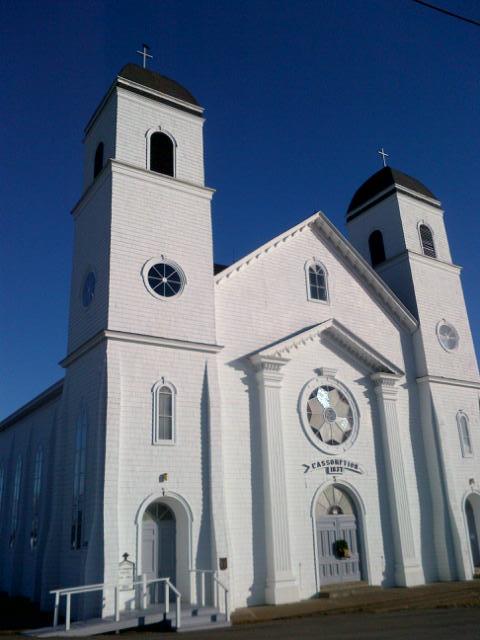|
William Fraser (Canadian Bishop)
William Fraser (1778 or 1779 Strathglass, Inverness-shire Scotland – October 4, 1851 Arichat, Nova Scotia, Canada) was a Canadian Roman Catholic priest and the first Bishop of Halifax in Nova Scotia from 1842 to July 20, 1845. He was Bishop of Arichat from September 22, 1844 (now the Diocese of Antigonish). The difference in the dates is due to the splitting of the diocese into two dioceses effective September 22, 1844, and Fraser remaining Bishop of Halifax until such time that William Walsh took formal possession of the Diocese of Halifax. In folklore *In both Scottish and Canadian folklore, Bishop Fraser is a folk hero. He is said to have been a man of enormous physical strength and to have been able to break steel horseshoes with his bare hands. On both sides of the Atlantic Ocean, many legends have been collected of the Bishop's exploits. In Canadian literature * Despite his devotion to the Catholic Faith, poet Ailean a' Ridse MacDhòmhnaill, a major figure ... [...More Info...] [...Related Items...] OR: [Wikipedia] [Google] [Baidu] |
Strathglass
Strathglass is a strath or wide and shallow valley in the Northwest Highlands of Scotland down which runs the meandering River Glass from the point at which it starts at the confluence of the River Affric and Abhainn Deabhag to the point where, on joining with the River Farrar at Struy, the combined waters become the River Beauly. The A831 road runs southwest from the vicinity of Erchless Castle up the length of Strathglass and serves the village of Cannich which is the largest settlement within the valley. The road then runs east from here via Glen Urquhart to Drumnadrochit beside Loch Ness. A minor road continues southwest up the valley from Cannich towards Glen Affric. Strathglass was also followed by a line of electricity pylons but that has been replaced by a line of new pylons across Eskdale Moor to the east of the strath. Both flanks of the valley are heavily wooded; on the higher ground to the northwest, beyond the forests are the moors of Struy Forest and Balmore Fores ... [...More Info...] [...Related Items...] OR: [Wikipedia] [Google] [Baidu] |
Scottish Gaelic Literature
Scottish Gaelic literature refers to literature composed in the Scottish Gaelic language and in the Gàidhealtachd communities where it is and has been spoken. Scottish Gaelic is a member of the Goidelic branch of Celtic languages, along with Irish and Manx. Middle Ages Early Middle Ages In early Middle Ages what is now Scotland was culturally and politically divided. In the West were the Gaels of Dál Riata, who had close links with the clan system of Gaelic Ireland, from whence they had migrated and brought with them the name of Scots. Very few works of Gaelic poetry survive from the early Medieval period, and most of these are in Irish manuscripts.J. T. Koch, ''Celtic Culture: a Historical Encyclopedia'' (ABC-CLIO, 2006), , p. 1576. There are works of Christian poetry that can be identified as Scottish, including the ''Elegy for St Columba'' by Dallán Forgaill (c. 597) and "In Praise of St Columba" by Beccan mac Luigdech of Rùm, c. 677. A series of anecdotes contained in th ... [...More Info...] [...Related Items...] OR: [Wikipedia] [Google] [Baidu] |
Roman Catholic Diocese Of Antigonish
The Roman Catholic Diocese of Antigonish ( la, Dioecesis Antigonicensis) is a Latin Rite diocese in Nova Scotia, Canada. Its current diocesan ordinary is Wayne Joseph Kirkpatrick. History The Diocese was established on 22 September 1844, under the name of the Diocese of Arichat, on territory split off from the Diocese of Halifax. Its proto-cathedral (now Église Notre Dame de l’Assomption) was located on Cape Breton Island, in the port town of Arichat. In both Scottish and Canadian folklore, the first ordinary of the Diocese, Bishop William Fraser of Strathglass, is a folk hero. He is said to have been a man of enormous physical strength and to have been able to break steel horseshoes with his bare hands. On both sides of the Atlantic Ocean, many legends have been collected of the Bishop's exploits. On 23 August 1886, the diocese was renamed the Diocese of Antigonish, and its episcopal see moved to St. Ninian's Cathedral, on the Nova Scotia mainland in the town of ... [...More Info...] [...Related Items...] OR: [Wikipedia] [Google] [Baidu] |
José Antonio García Balsalobre Y Rada
José is a predominantly Spanish and Portuguese form of the given name Joseph. While spelled alike, this name is pronounced differently in each language: Spanish ; Portuguese (or ). In French, the name ''José'', pronounced , is an old vernacular form of Joseph, which is also in current usage as a given name. José is also commonly used as part of masculine name composites, such as José Manuel, José Maria or Antonio José, and also in female name composites like Maria José or Marie-José. The feminine written form is ''Josée'' as in French. In Netherlandic Dutch, however, ''José'' is a feminine given name and is pronounced ; it may occur as part of name composites like Marie-José or as a feminine first name in its own right; it can also be short for the name ''Josina'' and even a Dutch hypocorism of the name ''Johanna''. In England, Jose is originally a Romano-Celtic surname, and people with this family name can usually be found in, or traced to, the English county ... [...More Info...] [...Related Items...] OR: [Wikipedia] [Google] [Baidu] |


